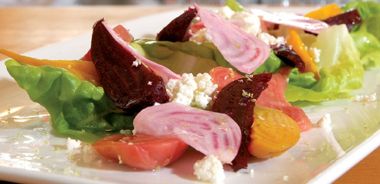Roasted Heirloom Beet and Butter Lettuce Salad

Various types of beets and honey can take this dish in plenty of delicious directions. Honey takes its flavour from the fields that surround the apiary and there are many varieties to explore, ranging from fireweed to blueberry to wildflower.
1 lb (450 g) heirloom beets, as many varieties as you find
6 Tbsp (90 mL) extra-virgin olive oil
1/2 bunch fresh thyme
2 heads butter lettuce, washed and dried well
1/2 cup (125 mL) ricotta cheese
3 limes
1/2 cup (125 mL) fireweed honey (or any high-quality honey you like)
3/4 cup (180 mL) peanut oil
Salt
Black pepper, freshly ground
To roast beets, preheat oven to 350 F (180 C). Wash and trim beets before placing in ovenproof dish, ensuring all are roughly the same size. Drizzle with olive oil, season with salt and pepper, and toss with sprigs of fresh thyme.
Roast until tender (40 to 60 minutes, depending on size). Check with tip of sharp knife: they should offer no resistance. Remove beets from oven and cool until you are able to handle them. Peel beets and cut into irregular shapes. This can be done up to a day ahead.
To make dressing, zest and juice limes, reserve the zest, and place juice in bowl. Pour in honey and slowly whisk in peanut oil. Season dressing to taste.
To make salad, divide leaves of butter lettuce among six cold plates. Toss beets with a portion of the dressing and divide among the plates. Using a spoon, make small mounds of ricotta on salads. Sprinkle tops with lime zest and top each salad with more dressing.
Serves 6.
Source: "Fuel Restaurant", alive #307, May 2008




